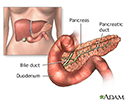Trypsin and chymotrypsin in stool
Stool - trypsin and chymotrypsin
Trypsin and chymotrypsin are substances released from the pancreas during normal digestion. When the pancreas does not produce enough trypsin and chymotrypsin, smaller-than-normal amounts can be seen in a stool sample.
This article discusses the test to measure trypsin and chymotrypsin in stool.
How the Test is Performed
There are many ways to collect the samples. Your health care provider will tell you how to collect the stool.
You can catch the stool on plastic wrap that is loosely placed over the toilet bowl and held in place by the toilet seat. Then put the sample in a clean container. One type of test kit contains a special tissue that you use to collect the sample. Then you put the sample in a clean container.
To collect a sample from infants and young children:
- If the child wears a diaper, line the diaper with plastic wrap.
- Place the plastic wrap so that urine and stool do not mix.
A drop of stool is placed on a thin layer of gelatin. If trypsin or chymotrypsin are present, the gelatin will clear.
How to Prepare for the Test
Your health care provider will provide you with the supplies needed to collect the stool.
Why the Test is Performed
These tests are simple ways of finding out whether you have a decrease in pancreas function. This is most often due to chronic pancreatitis .
Chronic pancreatitis
Pancreatitis is swelling of the pancreas. Chronic pancreatitis is present when this problem does not heal or improve, gets worse over time, and lead...

These tests are most often done in young children who are thought to have cystic fibrosis .
Cystic fibrosis
Cystic fibrosis is a disease that causes thick, sticky mucus to build up in the lungs, digestive tract, and other areas of the body. It is one of th...

Note: This test is used as a screening tool for cystic fibrosis but it does not diagnose cystic fibrosis. Other tests are needed to confirm a diagnosis of cystic fibrosis.
Normal Results
The result is normal if there is a normal amount of trypsin or chymotrypsin in the stool.
What Abnormal Results Mean
An abnormal result means the trypsin or chymotrypsin levels in your stool are below the normal range. This may mean that your pancreas is not working properly. Other tests may be done to confirm that there is a problem with your pancreas.
References
Forsmark C. Chronic pancreatitis. In: Feldman M, Friedman LS, Brandt LJ, eds. Sleisinger and Fordtran's Gastrointestinal and Liver Disease . 9th ed. Philadelphia, PA: Elsevier Saunders; 2010:chap 59.
Forsmark C. Pancreatitis. In: Goldman L, Schafer AI, eds. Goldman-Cecil Medicine . 25th ed. Philadelphia, PA: Elsevier Saunders; 2016:chap 144.
Pincus MR, Abraham NZ, Carty RP. Clinical enzymology. In: McPherson RA, Pincus MR, eds. Henry's Clinical Diagnosis and Management by Laboratory Methods . 22nd ed. Philadelphia, PA: Elsevier Saunders; 2011:chap 20.
-
Digestive system organs - illustration
The digestive system organs in the abdominal cavity include the liver, gallbladder, stomach, small intestine and large intestine.
Digestive system organs
illustration
-
Pancreas - illustration
The pancreas is located behind the liver and is where the hormone insulin is produced. Insulin is used by the body to store and utilize glucose.
Pancreas
illustration
-
Digestive system organs - illustration
The digestive system organs in the abdominal cavity include the liver, gallbladder, stomach, small intestine and large intestine.
Digestive system organs
illustration
-
Pancreas - illustration
The pancreas is located behind the liver and is where the hormone insulin is produced. Insulin is used by the body to store and utilize glucose.
Pancreas
illustration
Review Date: 2/11/2015
Reviewed By: Subodh K. Lal, MD, gastroenterologist with gastrointestinal specialists of Georgia, Austell, GA. Review provided by VeriMed Healthcare Network. Also reviewed by David Zieve, MD, MHA, Isla Ogilvie, PhD, and the A.D.A.M. Editorial team.


